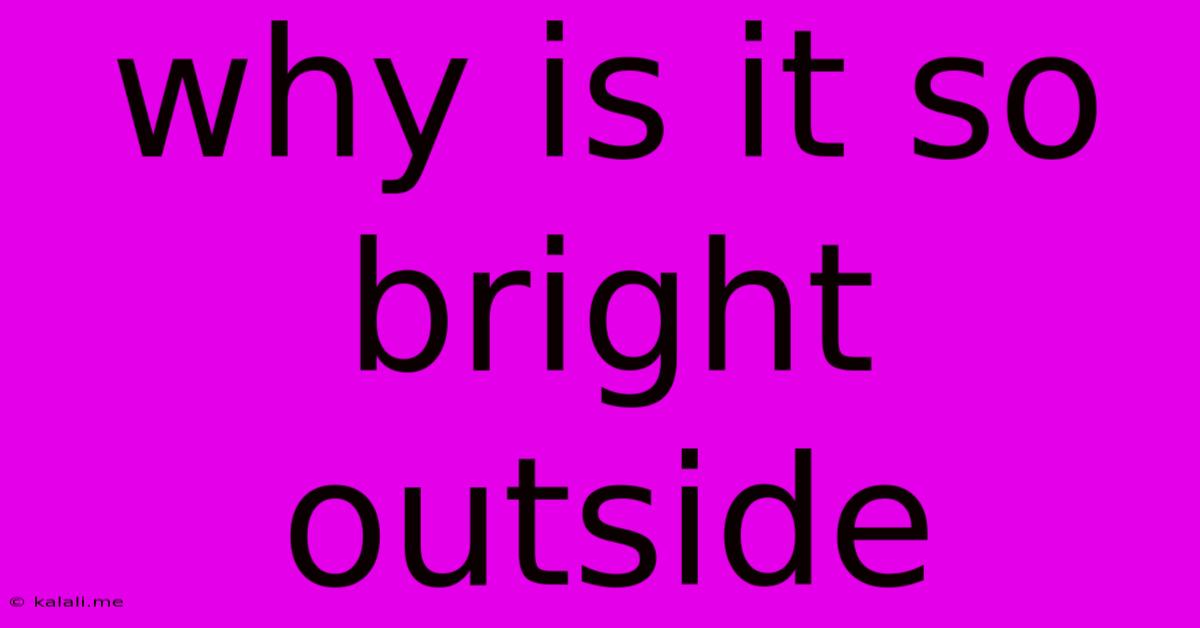Why Is It So Bright Outside
Kalali
May 27, 2025 · 3 min read

Table of Contents
Why Is It So Bright Outside? Understanding the Science of Sunlight
Why is it so bright outside? It seems like a simple question, but the answer delves into the fascinating science of light, the sun, and our atmosphere. This brightness, crucial for life on Earth, is a result of several interacting factors. Let's explore them.
The Sun: Our Primary Light Source
The most obvious reason for brightness is, of course, the sun. This massive star is a constant source of energy, emitting a vast amount of electromagnetic radiation, including visible light. The sun's brightness isn't constant; it varies throughout the year due to Earth's elliptical orbit and axial tilt. We experience this variation as the seasons change, with longer, brighter days in summer and shorter, dimmer days in winter. Solar flares and sunspots can also cause temporary increases in brightness. Understanding the sun's activity is crucial to understanding the fluctuations in daylight brightness.
Atmospheric Effects: Scattering and Absorption
While the sun is the source, the Earth's atmosphere plays a significant role in how bright the sunlight appears. Several processes influence the brightness we perceive:
Rayleigh Scattering: The Blue Sky Effect
Rayleigh scattering is responsible for the blue color of the sky. It occurs when sunlight interacts with tiny air molecules (primarily nitrogen and oxygen). Shorter wavelengths of light, like blue and violet, are scattered more effectively than longer wavelengths, like red and orange. This scattering distributes blue light in all directions, making the sky appear blue. The amount of scattering, and therefore the perceived brightness, depends on the atmospheric conditions, such as the presence of dust, pollutants, or clouds.
Mie Scattering: Haze and Brightness
Mie scattering involves larger particles in the atmosphere, such as dust, pollen, and water droplets. This scattering process affects all wavelengths of light more equally, leading to a hazy or milky appearance. Increased Mie scattering can reduce the overall brightness by diffusing the light, while simultaneously making the sky appear less blue and more white or gray.
Absorption: Reducing Brightness
Certain atmospheric components, like ozone and water vapor, absorb some of the sunlight before it reaches the ground. This absorption reduces the intensity of the light, thus affecting perceived brightness. Higher levels of atmospheric pollutants can also contribute to increased absorption, reducing brightness.
Time of Day and Season: Varying Brightness
The angle of the sun in the sky significantly impacts brightness. At midday, the sun is directly overhead (or close to it), resulting in more direct sunlight and thus increased brightness. In the morning and evening, the sun's rays pass through a greater thickness of atmosphere, leading to more scattering and absorption, resulting in a softer, less intense light. Similarly, the seasons impact brightness due to changes in the sun's angle and the length of daylight hours.
Weather Conditions: Clouds and Brightness
Clouds play a major role in brightness. Thick, dark clouds can significantly reduce the amount of sunlight reaching the surface, making it appear dim. Thin, wispy clouds, however, can actually enhance brightness by scattering light in a way that creates a diffused, but still bright, illumination. The type and density of clouds significantly impact perceived brightness.
Conclusion: A Complex Interaction
The brightness we experience outside is a complex interplay of the sun's intensity, atmospheric scattering and absorption, the time of day and season, and prevailing weather conditions. Understanding these factors helps us appreciate the science behind this everyday phenomenon and how various environmental conditions affect our perception of light.
Latest Posts
Latest Posts
-
How To Get Urine Smell Out Of Wood
May 28, 2025
-
How Does A Heat Pump Work In Winter
May 28, 2025
-
How To Tighten Faucet Nut Under Sink
May 28, 2025
-
Scp Copy From Local To Remote
May 28, 2025
-
Ha Ha Ha Jokes On You Batman
May 28, 2025
Related Post
Thank you for visiting our website which covers about Why Is It So Bright Outside . We hope the information provided has been useful to you. Feel free to contact us if you have any questions or need further assistance. See you next time and don't miss to bookmark.